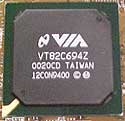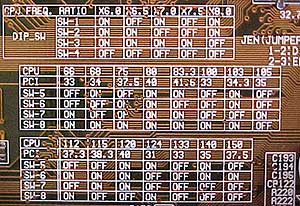Asus CUV4X Motherboard Review
Asus is perhaps the
most prominent motherboard maker around, they are renown for
quality, stability and speed. The Asus CUV4X hopes to carry
on the tradition, while using the VIA 133Z (essentially the 133A, except for Socketed
processors) chipset.
|

|
|
The Asus CUV4X comes complete with an instruction
manual, a
driver CD, an UltraATA/66 cable, a serial port connector, USB connector, as
well as a floppy drive cable. All for about $168 CDN / $113
USD |
 As with all Asus motherboards, the CUV4X is just a
plain brown PCB. The CUV4X uses the VIA 133Z chipset
which enables a few important features, these include native ATA66
compatibility as well as AGP 4X, and true PC133/133mhz FSB support.
As with all Asus motherboards, the CUV4X is just a
plain brown PCB. The CUV4X uses the VIA 133Z chipset
which enables a few important features, these include native ATA66
compatibility as well as AGP 4X, and true PC133/133mhz FSB support.
The
CUV4X supports Celeron's and PIII's in PPGA and FCPGA form factors.
|
 
|
| The VIA 133Z chipset at the heart of
the Asus CUV4X is cooled by a cheap thermal compound-less green
heatsink. Confronted with these green heatsinks, it's almost a wiser
choice to try and get a board with a glued on heatsink - at least that
way, you know it is making contact! |
Supported CPU speeds on this little board range from 300Mhz (Celeron
Mendocino) all the way to 1GHZ and beyond (PIII Coppermine). I guess Asus is planning for
the future here, but this will probably end up being fairly redundant.
There is
also a jumper by the 3rd DIMM slot that enables Cyrix CPU support. The
main dipswitch allows you to manually set your CPU parameters (voltage and front side
bus). Perhaps most importantly, the VIA 133Z chipset allows you to
run AGP cards with 133Mhz FSB with relative ease since the VIA 133 series of
chipsets are blessed with 1/2 AGP dividers at 133Mhz FSB and beyond.

The asynchronous RAM timings are also useful, they allow you
to run 133Mhz FSB CPU's with PC-100 memory, or add 33Mhz to the memory bus
when using a 100Mhz FSB CPU for that pseudo 133Mhz FSB effect; useful for Celeron
overclockers..... Onto the AGP chipset...

